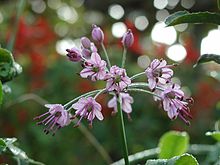| Chinese onion | |
|---|---|

| |
|
Scientific classification
| |
| Kingdom: | Plantae |
| Clade: | Tracheophytes |
| Clade: | Angiosperms |
| Clade: | Monocots |
| Order: | Asparagales |
| Family: | Amaryllidaceae |
| Subfamily: | Allioideae |
| Genus: | Allium |
| Subgenus: | A. subg. Cepa |
| Species: | A. chinense
|
| Binomial name | |
| Allium chinense | |
| Synonyms [2] | |
|
Synonymy
| |
Allium chinense (also known as Chinese onion, [3] [4] Chinese scallion, [3] glittering chive, [5] Japanese scallion, [3] Kiangsi scallion, [4] and Oriental onion [3]) is an edible species of Allium, native to China, [3] and cultivated in many other countries. [6] Its close relatives include the onion, scallion, leek, chive, and garlic. [7]

Distribution
Allium chinense is native to China (in Anhui, Fujian, Guangdong, Guangxi, Guizhou, Hainan, Henan, Hubei, Hunan, Jiangxi, and Zhejiang provinces). [3] It is naturalized in other parts of Asia as well as in North America. [3] [8] [9]
Uses
Culinary
Owing to its very mild and "fresh" taste, A. chinense is often pickled and served as a side dish in Japan and Vietnam to balance the stronger flavor of some other component in a meal. For example, in Japanese cuisine, it is eaten as a garnish on Japanese curry. [10]
In Vietnam, pickled A. chinense, known as củ kiệu, is often served during Tết (Lunar New Year).[ citation needed]
In Japanese, it is known as rakkyō (辣韮 or 薤). Glass bottles of white rakkyō bulb pickles are sold in Asian supermarkets in North America. [11]
Medicinal
Allium chinense is used as a folk medicine in tonics to help the intestines, and as a stomachic. [12]
See also
- Allium tuberosum, also known as garlic chives – Species of onion native to southwestern parts of the Chinese province of Shanxi
- Pickled onion – Onions pickled in a solution of vinegar or salt
References
- ^ Brummitt, N. (2013). "Allium chinense". IUCN Red List of Threatened Species. 2013: e.T44392537A44396666. doi: 10.2305/IUCN.UK.2013-2.RLTS.T44392537A44396666.en. Retrieved 18 November 2021.
- ^ a b "Allium chinense". World Checklist of Selected Plant Families. Royal Botanic Gardens, Kew. Retrieved 2013-05-28.
- ^ a b c d e f g "Allium chinense". Germplasm Resources Information Network. Agricultural Research Service, United States Department of Agriculture. Retrieved 2017-12-15.
- ^ a b Multilingual Multiscript Plant Name Database: Allium. University of Melbourne. Updated 3 August 2013. Retrieved 5 September 2014.
- ^ English Names for Korean Native Plants (PDF). Pocheon: Korea National Arboretum. 2015. p. 347. ISBN 978-89-97450-98-5. Archived from the original (PDF) on 25 May 2017. Retrieved 17 December 2016 – via Korea Forest Service.
- ^ Flora of China Vol. 24 Page 196 藠头 jiao tou Allium chinense G. Don, Mem. Wern. Nat. Hist. Soc. 6: 83. 1827.
- ^ Block, E. (2010). Garlic and Other Alliums: The Lore and the Science. Royal Society of Chemistry. ISBN 978-0-85404-190-9.
- ^ "Allium chinense Rakkyo PFAF Plant Database". pfaf.org. Retrieved 2021-11-10.
- ^ USDA, NRCS (n.d.). "Allium chinense". The PLANTS Database (plants.usda.gov). Greensboro, North Carolina: National Plant Data Team. Retrieved 7 June 2022.
- ^ "Japanese beef curry (Curry Rice)". JustHungry. 2007-02-06. Archived from the original on 2007-02-08. Retrieved 2021-11-10.
- ^ "Niitakaya Rakkyo". Asia Mart, Santa Rosa. Archived from the original on 2021-12-02. Retrieved 2023-06-24.
- ^ James A. Duke. "Allium chinense (LILIACEAE)". Dr. Duke's Phytochemical and Ethnobotanical Databases. Retrieved 2017-12-15.
